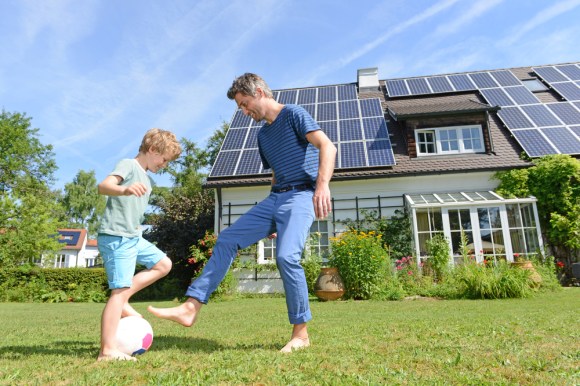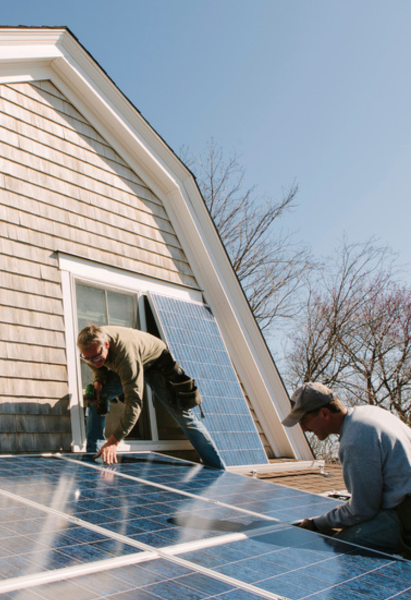Clean energy plays a key role in protecting the environment, and the Residential Clean Energy Credit makes clean energy more accessible for homeowners.
If you’re thinking about installing solar panels on your home or investing in a geothermal heat pump, you can benefit from residential energy credits.
So how do these credits work, and who qualifies for them? We’ve got everything you need to know in this guide.
What is the Residential Clean Energy Credit?
While it began as the Nonbusiness Energy Property Credit, the Residential Clean Energy Credit was extended under the Inflation Reduction Act in 2022. This new name brought several changes, including higher limits and the removal of the lifetime credit limit.
The Residential Clean Energy Credit is a tax credit that you may qualify for if you’re installing clean energy property for your home. If you qualify, you can use the Residential Clean Energy Credit to lower your tax bill.
This tax credit is nonrefundable, which means you can’t receive more credit than you owe in taxes. However, you can use the excess credit to save on your taxes in the following year. Consider planning out how you’re going to use your tax credit before you purchase a clean energy property to ensure you can take advantage of these valuable tax credits.
While similar, the Residential Clean Energy Credit isn’t a tax deduction. What’s the difference between a tax credit vs. deduction? Tax credits are a dollar-for-dollar reduction of your tax bill, while deductions lower your taxable income.
What is considered renewable energy?
Renewable energy is any energy source that’s replenished faster than it’s consumed.
For the sake of the residential energy credit, there are only a handful of energy-efficient home improvements that qualify:
- Solar panels: If you install solar panels on your home, you may qualify for the Residential Clean Energy Credit. The solar tax credit can cover a percentage of the total cost of your solar power system installation.
- Solar water heaters: Water heaters use a lot of energy, so switching to solar can help you save on your monthly bill. In order to qualify for the residential energy credit, your water heater must be certified by the Solar Rating Certification Corporation or a similar entity.
- Wind turbines: Wind electric systems are more common in commercial settings, but there are also residential wind turbines. If you install a qualifying residential wind power system, you may qualify for the Residential Clean Energy Credit.
- Geothermal heat pumps: Geothermal heat pumps work by either storing heat in the ground or pulling heat from the ground to heat your home. A geothermal heat pump can be a smart upgrade if you live in the right climate. Geothermal heat pumps must meet ENERGY STAR requirements to qualify.
- Fuel cells: Fuel cells allow you to store power that you’ve generated with a wind or solar system, so you can use that power when your wind or solar system isn’t producing enough power.
- Battery storage technology: Battery storage also allows you to store excess power created by your solar or wind system. Battery storage qualifies for the Residential Clean Energy Credit beginning in 2023. To qualify, battery storage technology must have a capacity of at least 3 kWh.
Between energy-efficient home improvements and qualified heat pumps, biomass stoves, and biomass boilers, you can receive a maximum credit of $3,200 each year. Your total credit can be spread out across several years.
Keep in mind that used clean energy property isn’t eligible for the Residential Clean Energy Credit, so you need to purchase a new system to qualify. Certain installation costs may not be eligible for the residential energy credit.
How much is the Residential Energy Credit worth?
The Residential Clean Energy Credit is 30% of the cost of installing a new clean energy property between 2022 and 2032. For clean energy property that’s installed in 2033, that rate goes down to 26%. Clean energy property installed in 2034 qualifies for a 22% tax credit.

It’s important to keep in mind that the Residential Clean Energy Credit may not cover certain installation costs, including roofing and other structural components. If you’re planning on building your dream home, get an itemized quote for any renewable power installation.
There are also different rules if you use your home for business use:
- You can’t claim the credit if you use your home solely for business purposes.
- You’ll receive the full credit for using up to 20% of your home for business.
- If you use more than 20% of the property for business use, you’ll receive a credit based on the portion of the expense allocated to nonbusiness use.
Credit limits
If you’re investing in fuel cells, you should know about the credit limits for fuel cell property. Credit is limited to $500 per half kilowatt of capacity, and the total credit for a home with multiple residents can’t exceed $1,667 per half kilowatt of capacity.
Each year, you can claim up to $1,200 for energy property costs and home improvements. There’s a $250 limit per door with a $500 total, a $600 limit for windows, and a $150 limit for home energy audits.
Who qualifies for the Residential Clean Energy Credit?
There are specific requirements you need to meet to qualify for the Residential Clean Energy Credit. While many people qualify for the residential energy credit, you need to meet certain criteria and invest in the right energy-efficient upgrades for your home.
Here’s a quick breakdown of who qualifies for the Residential Clean Energy Credit and what you need to consider before completing Form 5695.
Do landlords qualify for the clean energy credit?
The clean energy credit isn’t available to landlords and other property owners who don’t live in the home that’s being upgraded. If you own a second home that you don’t rent to anyone and live in part-time, you may be able to claim the residential energy credit.
If you are claiming the Residential Clean Energy Credit on a second home, there are restrictions. For example, you can’t claim a credit for fuel cell property for your second home. You can learn more on the IRS website.
Do renters qualify for the residential energy credit?
What if you’re not buying a house and you’re just renting?
Even if you rent your home, you may qualify for the Residential Clean Energy Credit if you install clean energy property. If you rent, it’s important to talk to your landlord or property management company before investing in home improvements.

Is there an income limit?
There’s no income limit on the residential energy credit, which means you can qualify for this credit even if you’re in a higher tax bracket. As long as you’re purchasing qualifying clean energy property, you can claim the Residential Clean Energy Credit for that tax year.
Is there a lifetime credit limit?
While there’s a limit for the credit amount you can receive each year, there’s no lifetime limit. This means you can continue claiming the Residential Clean Energy Credit year after year — as long as you have a qualifying clean energy property installed that year.
The residential energy credit isn’t refundable, which means you can’t receive more credit than you owe. Fortunately, you can roll that credit over to reduce your tax bill in the following year or two, so you don’t have to worry about losing part of your credit.
Can multiple residents claim the Residential Clean Energy Credit?
If you live in a home with multiple residents — other than your spouse — each resident will need to complete a separate Form 5965. For Fuel Cell Property, the household can receive a maximum of $1,667 per half kilowatt of fuel cell capacity.
The credit you receive for fuel cell property costs will be the amount you paid or the maximum qualifying cost of the property multiplied by a fraction. You’ll receive whichever amount is lower.
No matter what moves you made last year, TurboTax will make them count on your taxes. Whether you want to do your taxes yourself or have a TurboTax expert file for you, we’ll make sure you get every dollar you deserve and your biggest possible refund – guaranteed.
-
Previous Post
How to File an Extension: A Step-By-Step Guide
One response to “Residential Clean Energy Credit: A Homeowner’s Guide”

















